*NURSING > NCLEX-PN > RNSG 1205 (RNSG1205) LPN to RN Transitions (RNSG 1205 (RNSG1205) LPN to RN Transitions (All)
RNSG 1205 (RNSG1205) LPN to RN Transitions (RNSG 1205 (RNSG1205) LPN to RN Transitions
Document Content and Description Below
N Chapter 01: Honoring Your Past, Planning Your Future Claywell: LPN to RN Transitions, 4th Edition MULTIPLE CHOICE 1. A nursing advisor is meeting with a student who is interested in earning her RN d... egree. She knows that licensed practical nurse/license vocational nurse (LPN/LVNs) who enter nursing school to become RNs come into the learning environment with prior knowledge and understanding. Which statement by the nursing advisor best describes her understanding of the effect experience may have on learning? a. “Experience may be a source of insight and motivation, or a barrier.” b. “Experience is usually a stumbling block for LPN/LVNs.” c. “Experience never makes learning more difficult.” d. “Once something is learned, it can never be truly modified.” ANS: A Experience accentuates differences among learners and serves as a source of insight and motivation, but it can also be a barrier. Experience can serve as a foundation for defining the self. DIF: Cognitive Level: Application OBJ: Identify how experiences influence learning in adults. TOP: Adult Learning 2. There is a test on the cardiovascular system on Friday morning, and it is now Wednesday night. The student has already taken a vacation day from work Thursday night so that she can stay home and study. She is considering skipping her exercise class on Thursday morning to go to the library to prepare for the test. Which response best identifies the student’s outcome priority? a. Exercise class b. Going to the library c. Avoiding work by taking a vacation d. Doing well on the test on Friday ANS: D The outcome priority is the essential issue or need to be addressed at any given time within a set of conditions or circumstances. DIF: Cognitive Level: Application OBJ: Identify motivations and personal outcome priorities for returning to school. TOP: Motivation to Learn 3. A nurse who has been an LPN/LVN for 10 years is meeting with an advisor to discuss the possibility of taking classes to become an RN. The advisor interprets which statement by the nurse as the driving force for returning to school? a. “I’ll need to schedule time to attend classes.” b. “I’ll have to budget for paying tuition.” c. “I’ll have to rearranging my schedule.” d. “There is a possibility of advancement into administration.” ANS: D TEST BANK FOR LPN TO RN TRANSITIONS 4TH EDITION BY CLAYWELL N Driving forces are those that push toward making the change, as opposed to restraining forces, which are those that usually present a challenge that needs to be overcome for the change to take place or present a negative effect the change may initiate. DIF: Cognitive Level: Application OBJ: Identify motivations and personal outcome priorities for returning to school. TOP: Motivations for Change 4. An RN is caring for a diabetic patient. The patient appears interested in changing her lifestyle and has been asking questions about eating better. The nurse can interpret this behavior as which stage of Lewin’s Change Theory? a. Moving b. Unfreezing c. Action d. Refreezing ANS: B The patient is in the first phase of Lewin’s Change Theory, known as unfreezing. This phase involves determining that a change needs to occur and deciding to take action. Moving is the second phase and involves actively planning changes and taking action on them. Refreezing is the last stage, and it occurs when the change has become a part of the person’s life. DIF: Cognitive Level: Analysis OBJ: Understand Change Theory and how it applies to becoming an RN. TOP: Change Theory 5. An LPN is talking with her clinical instructor about her decision to return to school to become an RN. The clinical instructor interprets the LPNs outcome priority based on which statement? a. “My family wanted me to go back to school.” b. “I want to better my financial situation.” c. “I really enjoy school.” d. “I would like to advance to a teaching role someday.” ANS: B The outcome priority is the essential need that must be addressed, determined by internal and external factors, such as needing to better a financial situation. The other statements indicate reasons for returning to school, but they are not essential needs or issues to be addressed. DIF: Cognitive Level: Analysis OBJ: Identify how experiences influence learning in adults. TOP: Adult Learning 6. A nurse notices a posting for a management position for which she is qualified. If the nurse is in the moving phase of Lewin’s Change Theory, which statement reflects the action she is most likely to take? a. Does nothing to obtain the position b. Applies for the position c. Identifies that change is needed d. Settles into the routine of her job ANS: B TEST BANK FOR LPN TO RN TRANSITIONS 4TH EDITION BY CLAYWELL Chapter 01: Honoring Your Past, Planning Your Future Claywell: LPN to RN Transitions, 4th Edition MULTIPLE CHOICE 1. A nursing advisor is meeting with a student who is interested in earning her RN degree. She knows that licensed practical nurse/license vocational nurse (LPN/LVNs) who enter nursing school to become RNs come into the learning environment with prior knowledge and understanding. Which statement by the nursing advisor best describes her understanding of the effect experience may have on learning? a. “Experience may be a source of insight and motivation, or a barrier.” b. “Experience is usually a stumbling block for LPN/LVNs.” c. “Experience never makes learning more difficult.” d. “Once something is learned, it can never be truly modified.” ANS: A Experience accentuates differences among learners and serves as a source of insight and motivation, but it can also be a barrier. Experience can serve as a foundation for defining the self. DIF: Cognitive Level: Application OBJ: Identify how experiences influence learning in adults. TOP: Adult Learning 2. There is a test on the cardiovascular system on Friday morning, and it is now Wednesday night. The student has already taken a vacation day from work Thursday night so that she can stay home and study. She is considering skipping her exercise class on Thursday morning to N go to the library to prepare for the test. Which response best identifies the student’s outcome priority? a. Exercise class b. Going to the library c. Avoiding work by taking a vacation d. Doing well on the test on Friday ANS: D The outcome priority is the essential issue or need to be addressed at any given time within a set of conditions or circumstances. DIF: Cognitive Level: Application OBJ: Identify motivations and personal outcome priorities for returning to school. TOP: Motivation to Learn 3. A nurse who has been an LPN/LVN for 10 years is meeting with an advisor to discuss the possibility of taking classes to become an RN. The advisor interprets which statement by the nurse as the driving force for returning to school? a. “I’ll need to schedule time to attend classes.” b. “I’ll have to budget for paying tuition.” c. “I’ll have to rearranging my schedule.” d. “There is a possibility of advancement into administration.” ANS: D TESTBANKWORLD.ORG TEST BANK FOR LPN TO RN TRANSITIONS 4TH EDITION BY CLAYWELL Driving forces are those that push toward making the change, as opposed to restraining forces, which are those that usually present a challenge that needs to be overcome for the change to take place or present a negative effect the change may initiate. DIF: Cognitive Level: Application OBJ: Identify motivations and personal outcome priorities for returning to school. TOP: Motivations for Change 4. An RN is caring for a diabetic patient. The patient appears interested in changing her lifestyle and has been asking questions about eating better. The nurse can interpret this behavior as which stage of Lewin’s Change Theory? a. Moving b. Unfreezing c. Action d. Refreezing ANS: B The patient is in the first phase of Lewin’s Change Theory, known as unfreezing. This phase involves determining that a change needs to occur and deciding to take action. Moving is the second phase and involves actively planning changes and taking action on them. Refreezing is the last stage, and it occurs when the change has become a part of the person’s life. DIF: Cognitive Level: Analysis OBJ: Understand Change Theory and how it applies to becoming an RN. TOP: Change Theory 5. An LPN is talking with her clinical instructor about her decision to return to school to become N an RN. The clinical instructor interprets the LPNs outcome priority based on which statement? a. “My family wanted me to go back to school.” b. “I want to better my financial situation.” c. “I really enjoy school.” d. “I would like to advance to a teaching role someday.” ANS: B The outcome priority is the essential need that must be addressed, determined by internal and external factors, such as needing to better a financial situation. The other statements indicate reasons for returning to school, but they are not essential needs or issues to be addressed. DIF: Cognitive Level: Analysis OBJ: Identify how experiences influence learning in adults. TOP: Adult Learning 6. A nurse notices a posting for a management position for which she is qualified. If the nurse is in the moving phase of Lewin’s Change Theory, which statement reflects the action she is most likely to take? a. Does nothing to obtain the position b. Applies for the position c. Identifies that change is needed d. Settles into the routine of her job ANS: B TESTBANKWORLD.ORG TEST BANK FOR LPN TO RN TRANSITIONS 4TH EDITION BY CLAYWELL Unfreezing begins when reasons for change are identified. The moving phase involves active planning and action. Moving also means you are dealing with both positive and negative forces as they ebb and flow, and you are making modifications to your plan as needed. Refreezing occurs after the change has become routine. DIF: Cognitive Level: Application OBJ: Understand Change Theory and how it applies to becoming an RN. TOP: Change Theory 7. An Orthopedic Nurse is contemplating changes in her professional life and identifying goals. Which action should the nurse take if she is interested in pursuing a long-term goal? a. Studies for a telemetry exam scheduled for next week b. Enrolls in a Nurse Practitioner program c. Attends a seminar to become a charge nurse d. Continues to work on the orthopedic floor full-time ANS: B A short-term goal is one that can be attained in a period of 6 months or less. Short-term goals include becoming a charge nurse and passing the telemetry exam. A long-term goal is attained in greater than 6 months and includes studying to become a Nurse Practitioner. Continuing to work on the orthopedic floor does not represent either a short-term or a long-term goal. DIF: Cognitive Level: Application OBJ: Identify both short- and long-term personal and professional goals. TOP: Setting Goals 8. The RN is talking with the unit manager about ways to improve patient care. The manager N Which statement by the RN indicates that the teaching has introduces the concept of a cohort. been effective? a. “A cohort is a web of connections”. b. “A cohort is a group of people who share common experiences with each other”. c. “A cohort is a group linked together for common purposes”. d. “A cohort consists of groups of individuals that make up a whole”. ANS: B A cohort is a group of people who share common experiences with each other. A scheme is a web of connections, a team is a group linked together for common purposes, and a unit consists of groups or individuals that make up a whole. DIF: Cognitive Level: Evaluation OBJ: Identify how experiences influence learning in adults. TOP: Adult Learning 9. The nurse educator is presenting a lecture to a group of new RNs. Which statement by one of the RNs indicates that teaching has been effective? a. “Experience is a stepping stone to new learning”. b. “Experience can be a barrier to new learning”. c. “Experience can be an avenue to new learning”. d. “Experience can be a detour to new learning”. ANS: B Experience accentuates differences among learners, serves as a source of insight and motivation, can be a barrier to new learning, and serves as a foundation for defining the self. TESTBANKWORLD.ORG TEST BANK FOR LPN TO RN TRANSITIONS 4TH EDITION BY CLAYWELL DIF: Cognitive Level: Evaluation OBJ: Identify motivations and personal outcome priorities for returning to school. TOP: Adult Learning 10. The nurse educator is presenting a lecture on experience and learning to a group of RNs. Which statement by one of the RNs indicates that teaching has been effective? a. “Experiences always help educational endeavors”. b. “The process of unlearning is easier than the initial learning”. c. “Learning can often be more difficult if previous knowledge is contradicted”. d. “Experiences rarely serve the student in the learning process”. ANS: C Experiences may either help or hinder both present and future educational endeavors (Knowles et al., 2015). Experience may serve as a chain to which new learning may be linked, making concepts understandable within your personal context. Conversely, some experiences make learning more difficult in that new information may contradict previously accepted information and make it necessary to unlearn it. The process of unlearning is more difficult than initial learning. DIF: Cognitive Level: Evaluation OBJ: Delineate both positive and negative effect experiences. TOP: Adult Learning MULTIPLE RESPONSE 1. A student nurse and the staff RN are discussing recent changes on the nursing unit. Which of the following are examples of change processes? (Select all that apply.) N a. Coercive b. Collaborative c. Technocratic d. Planned e. Organized ANS: A, C, D Coercive is a type of change that is forced or pushed on another. A decision for change made by the most knowledgeable person is known as technocratic. Planned change involves careful thought and decision-making. Collaborative and organized are not considered to be types of change. DIF: Cognitive Level: Application OBJ: Understand Change Theory and how it applies to becoming an RN. TOP: Change Theory TESTBANKWORLD.ORG TEST BANK FOR LPN TO RN TRANSITIONS 4TH EDITION BY CLAYWELL Chapter 02: Assessing Yourself and Designing Success Claywell: LPN to RN Transitions, 4th Edition MULTIPLE CHOICE 1. After a particularly challenging examination, a student is overheard in the hallway exclaiming, “That instructor just grades too hard! She only gave me a B on the test!” This student is exhibiting traits of a(n) a. external locus of control. b. internal locus of control. c. perfectionist. d. realist. ANS: A Persons with an external locus of control often do not take responsibility for what happens to them. Persons with an internal locus of control take responsibility for what happens to them. A perfectionist strives for perfection in all that he or she does, which is a self-defeating behavior. A realist accepts the world as it is and handles it accordingly. DIF: Cognitive Level: Application OBJ: Interpret the role of locus of control on personal empowerment. TOP: Locus of Control 2. A student must come back to the learning laboratory to repeat the skills and check for insertion of a nasogastric tube. The instructor overhears the student saying, “I know I can do this, I know I can do this!” The instructor interprets this behavior as a. a self-defeating behavior. N b. positive self-talk. c. perfectionism. d. blaming. ANS: B The student is expressing positive self-talk by telling herself, “I know I can do this.” Stating “I can’t do this” is an example of a self-defeating behavior. A student expecting to perform tasks perfectly is striving for perfectionism. Blaming is not occurring here because the student is taking responsibility for his/her own actions. DIF: Cognitive Level: Analysis TOP: Self-Talk OBJ: Explain the impact of positive self-talk. 3. A clinical instructor notices that one of her students worries a lot, expects negative outcomes for most situations, strives for perfection, and seems to look for the tiniest faults in her work. The clinical instructor interprets these behaviors as a. commitment to learning. b. assuming an external locus of control. c. self-directedness. d. self-defeating behaviors. ANS: D TESTBANKWORLD.ORG TEST BANK FOR LPN TO RN TRANSITIONS 4TH EDITION BY CLAYWELL The student may be committed to learning, but she is showing signs of self-defeating behaviors. Self-defeating behaviors include pessimism, nit-picking, worrying, perfectionism, and blaming. Assuming an external locus of control means believing that action or inaction lies outside of oneself. Assuming ownership of learning defines self-directedness. DIF: Cognitive Level: Analysis OBJ: Describe self-defeating behaviors. TOP: Self-Defeating Behaviors and Empowerment 4. A nursing professor is grading an assignment on self-defeating behavior. The professor can expect to find which statement written by the student who has a good understanding of perfectionism? a. Perfection is impossible to attain, and therefore constantly falling short of perfection leads to negative feelings and beliefs about oneself. b. Perfection is the ultimate goal, and it is not a self-defeating behavior to demand it of oneself. c. Perfectionism is the only means by which we can truly improve. d. Perfectionism is a character flaw and cannot be addressed. ANS: A Perfection is impossible to obtain. Students who strive for perfection set themselves up for negative feelings and beliefs about themselves. DIF: Cognitive Level: Analysis TOP: Self-Defeating Behaviors OBJ: Describe self-defeating behaviors. 5. The nurse understands that there are four key habits for managing the work of success. Which action by the nurse demonstrates her understanding? a. Participating in a yoga classN b. Analyzing case studies on her day off c. Taking time at the beginning of the work shift to make a plan for her day d. Setting short- and long-term goals ANS: C The nurse understands that there are four key habits of success when she makes a plan for her day. Joining a yoga class, analyzing case studies, and setting short- and long-term goals are not defined as one of the four key habits. DIF: Cognitive Level: Application OBJ: Explain four key work habits that contribute to success. TOP: Managing the Work of Success 6. A student has a large reading assignment that must be completed in order to be prepared for the next class. Which action by the student would be ineffective in the planning process? a. Put off the assignment until later so more content is remembered. b. Examine your schedule to determine time frames for study sessions. c. Determine a study environment fitting your learning style. d. Divide the assignment into manageable chunks, and take notes as you read. ANS: A The time to begin to plan how to accomplish an assignment is the moment one is made aware of the assignment. TESTBANKWORLD.ORG TEST BANK FOR LPN TO RN TRANSITIONS 4TH EDITION BY CLAYWELL DIF: Cognitive Level: Application OBJ: Explain four key work habits that contribute to success. TOP: Managing the Work of Success 7. The roommate of a nursing student buys tickets to the student’s favorite play. The student realizes that the play is the night before her final exam. When the student turns down the tickets, the roommate interprets the student’s dedication to school as a. dedication to the plan until other mounting responsibilities interfere. b. total dedication, even in the face of other attractive opportunities. c. total dedication until resolve begins to wane. d. discipline to change the plan as needed. ANS: B Commitment requires discipline to maintain resolve even when other responsibilities or attractive opportunities begin to mount. DIF: Cognitive Level: Analysis OBJ: Explain four key work habits that contribute to success. TOP: Managing the Work of Success 8. A nursing student is learning about effective time management in her first semester of nursing school. Which action by the student indicates that she understands the first critical step? a. Setting goals based on the desired outcome b. Prioritizing goals in order of simple to complex c. Prioritizing tasks in chronological order d. Assessing the reality of the complete situation ANS: D N Assessing the complete situation is the first step in time management. One must be clear about the reality of the current set of tasks and schedule in order to begin to manage the time associated with the tasks. DIF: Cognitive Level: Application OBJ: Explain four key work habits that contribute to success. TOP: Managing the Work of Success 9. Stress reduction while in nursing school is an important part of maintaining one’s health. Holistic cognitive theory for stress reduction has four steps. The student shows that he or she understands the first step to achieving awareness by doing which of the following? a. Becomes aware of the early physical signs of stress b. Concentrates on placing himself or herself as the center of everything c. Mentally filters perceptions d. Disqualifies the positive in the experience ANS: A The awareness step is a time of understanding how the student feels under stress, coming to know the symptoms, and taking steps to neutralize the symptoms. DIF: Cognitive Level: Application TOP: Stress Reduction OBJ: Identify steps that aid in stress reduction. TESTBANKWORLD.ORG TEST BANK FOR LPN TO RN TRANSITIONS 4TH EDITION BY CLAYWELL 10. A student exclaims, “I have to make a 100% on this test because anything less is just like failing in my book. I either know it or I don’t and if I don’t know it now, I never will.” This student is obviously stressed, and the statements represent a. awareness reduction. b. cognitive distortions. c. positive coping mechanisms. d. acceptance of reality. ANS: B Cognitive distortions are illogical, irrational thoughts; those in this question are “all-or-nothing thinking” and “emotional reasoning.” DIF: Cognitive Level: Application TOP: Stress Reduction OBJ: Identify steps that aid in stress reduction. 11. A lab instructor is observing placement of a Foley catheter by a senior nursing student. If the student is in the active experimentation phase of Kolb’s Theory of Experiential Learning, what action can the lab instructor expect from the student? a. The student will need to observe placement before proceeding. b. The student assists the instructor in placing the catheter. c. The student places the Foley catheter without assistance. d. The student verbalizes beginning to understand catheter placement. ANS: C According to Kolb’s Theory of Experiential Learning, the student is in the active experimentation phase. When the student nurse places the Foley catheter, he or she is actively involved in the experience. Concrete experience occurs when the student is actively involved in a new experience. ReflectiveNobservation begins when the student observes the experience. Abstract conceptualization occurs when the student begins to understand the process of placing the Foley catheter. DIF: Cognitive Level: Analysis OBJ: Describe how learning style affects the learning process. TOP: Learning Style 12. A lab instructor is preparing to teach a group of students. After reading questionnaires filled out by the students in her group, she notes that the students would best learn by reflective observation. What activity should the instructor plan so that the students have the best chance of success? a. Set up stations so that the students can try to “figure it out for themselves.” b. Allow the students to observe a presentation. c. Present the information in a lecture while students take notes. d. Present information and allow the students to be directly involved in a hands-on setting. ANS: B Learning by observing is what Kolb terms reflective observation. Concrete experience involves hands-on learning. In active experimentation, students learn by trying to figure it out for themselves. Abstract conceptualization is the process of learning through data collection, such as lecture. DIF: Cognitive Level: Application TESTBANKWORLD.ORG TEST BANK FOR LPN TO RN TRANSITIONS 4TH EDITION BY CLAYWELL OBJ: Describe how learning style affects the learning process. TOP: Learning Style 13. A nurse is trying to manage success in the workplace. Which action demonstrates that she understands key habits that must be developed and maintained? a. Carefully list and organize the day’s tasks. b. Complete a task over again because it wasn’t done perfectly the first time. c. Avoid difficult tasks because they won’t be done correctly. d. Blame others for lack of organization. ANS: A Carefully listing and organizing the day’s tasks demonstrates that the . [Show More]
Last updated: 1 year ago
Preview 1 out of 141 pages
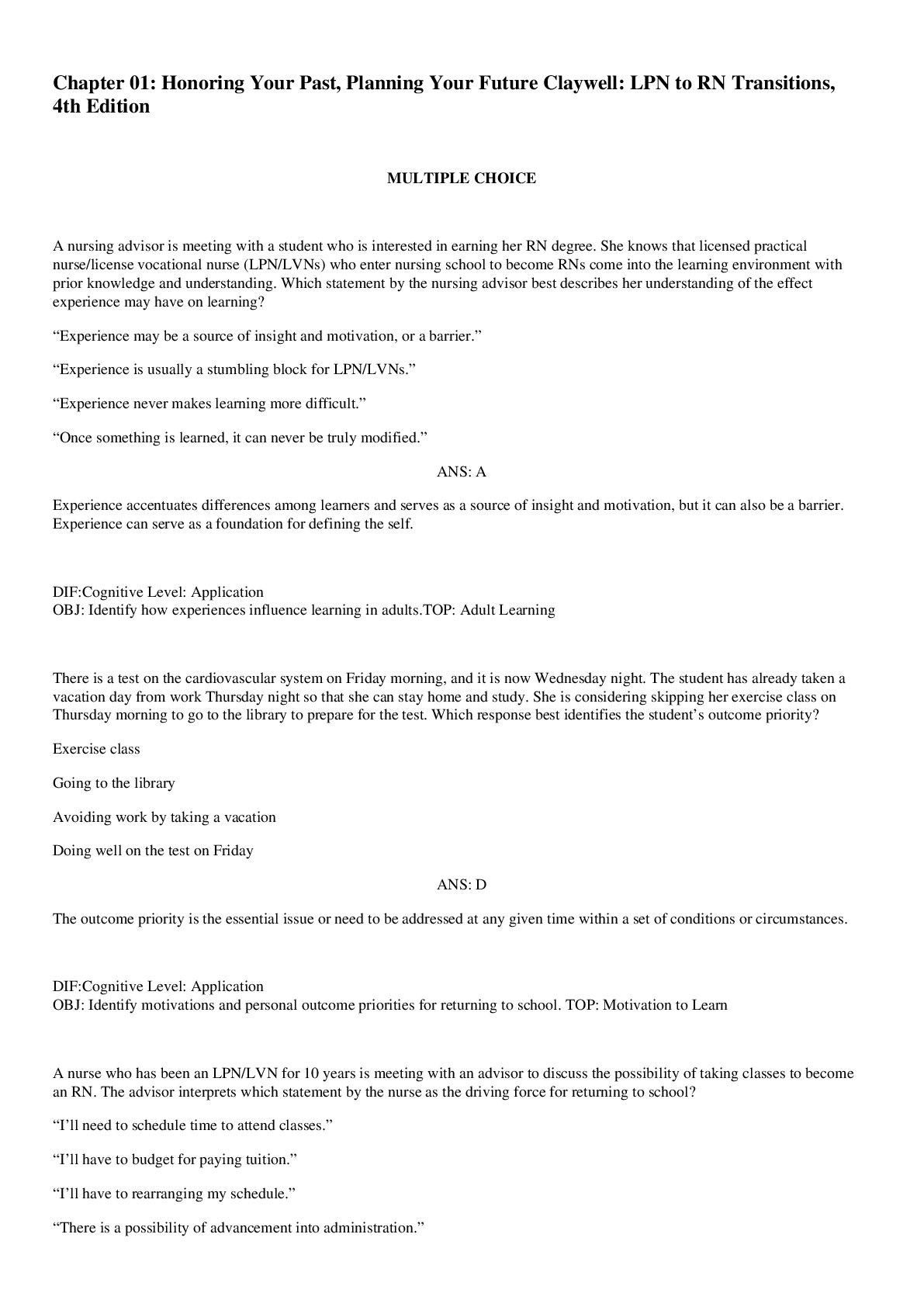
Reviews( 0 )
Document information
Connected school, study & course
About the document
Uploaded On
Mar 10, 2021
Number of pages
141
Written in
Additional information
This document has been written for:
Uploaded
Mar 10, 2021
Downloads
1
Views
84



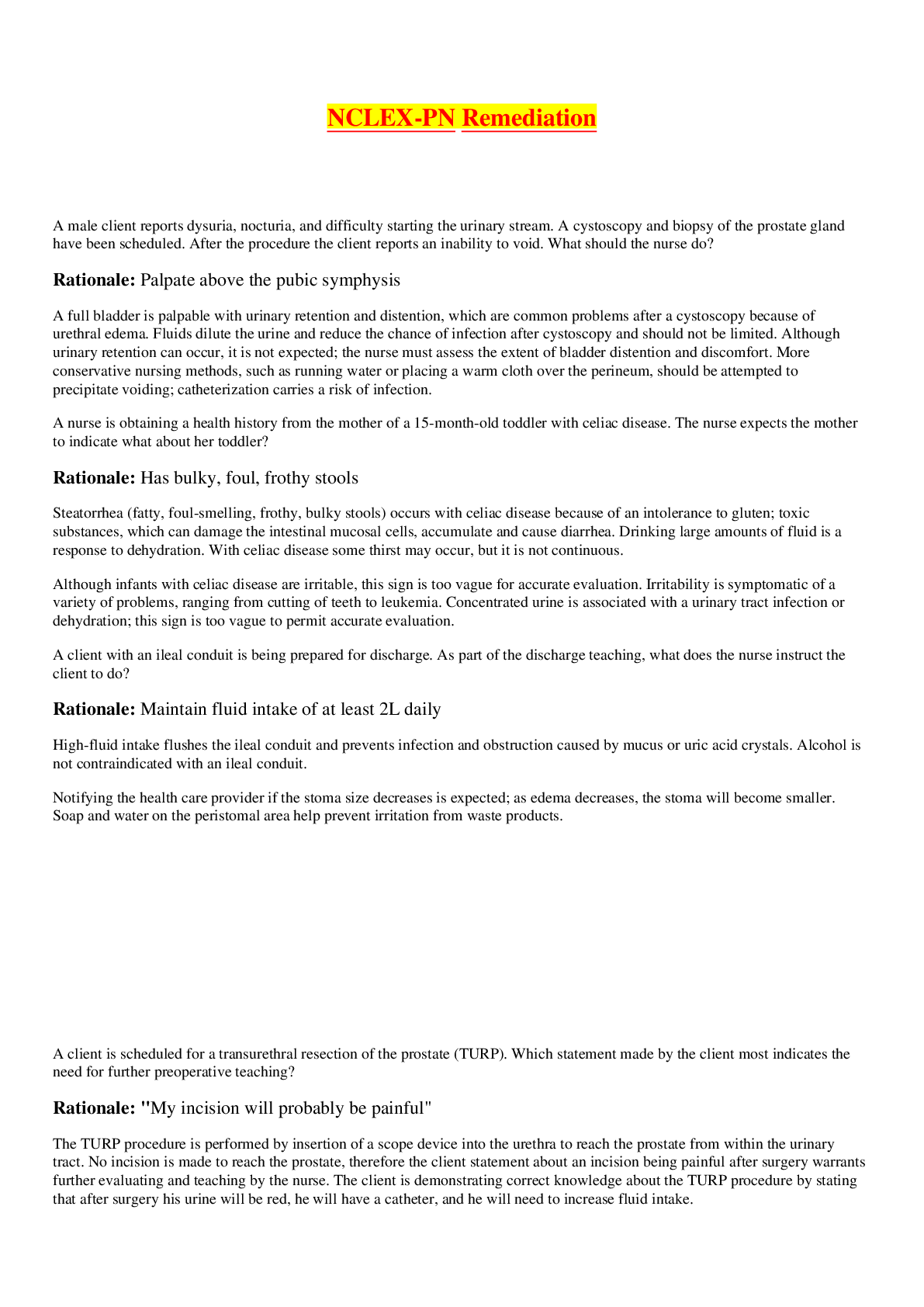
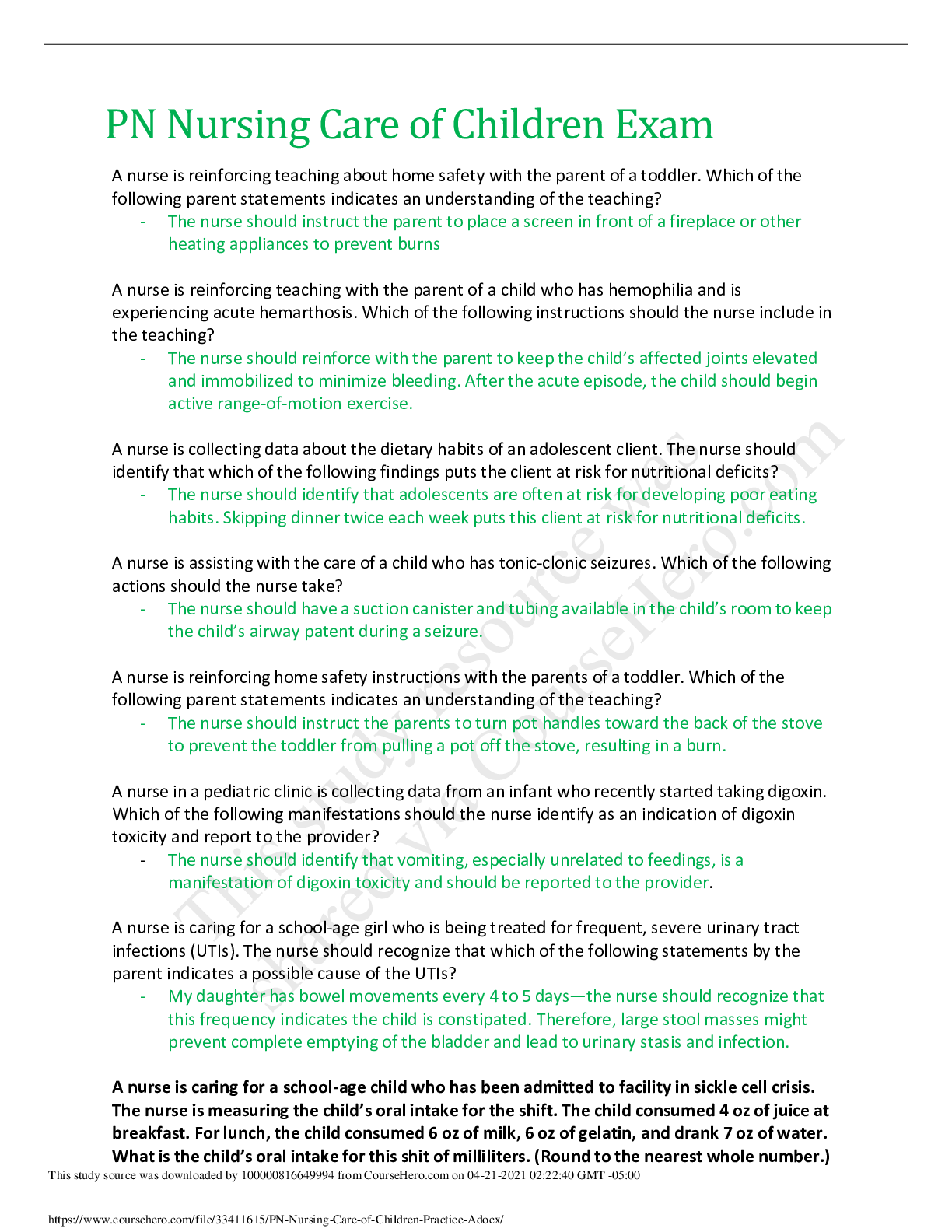

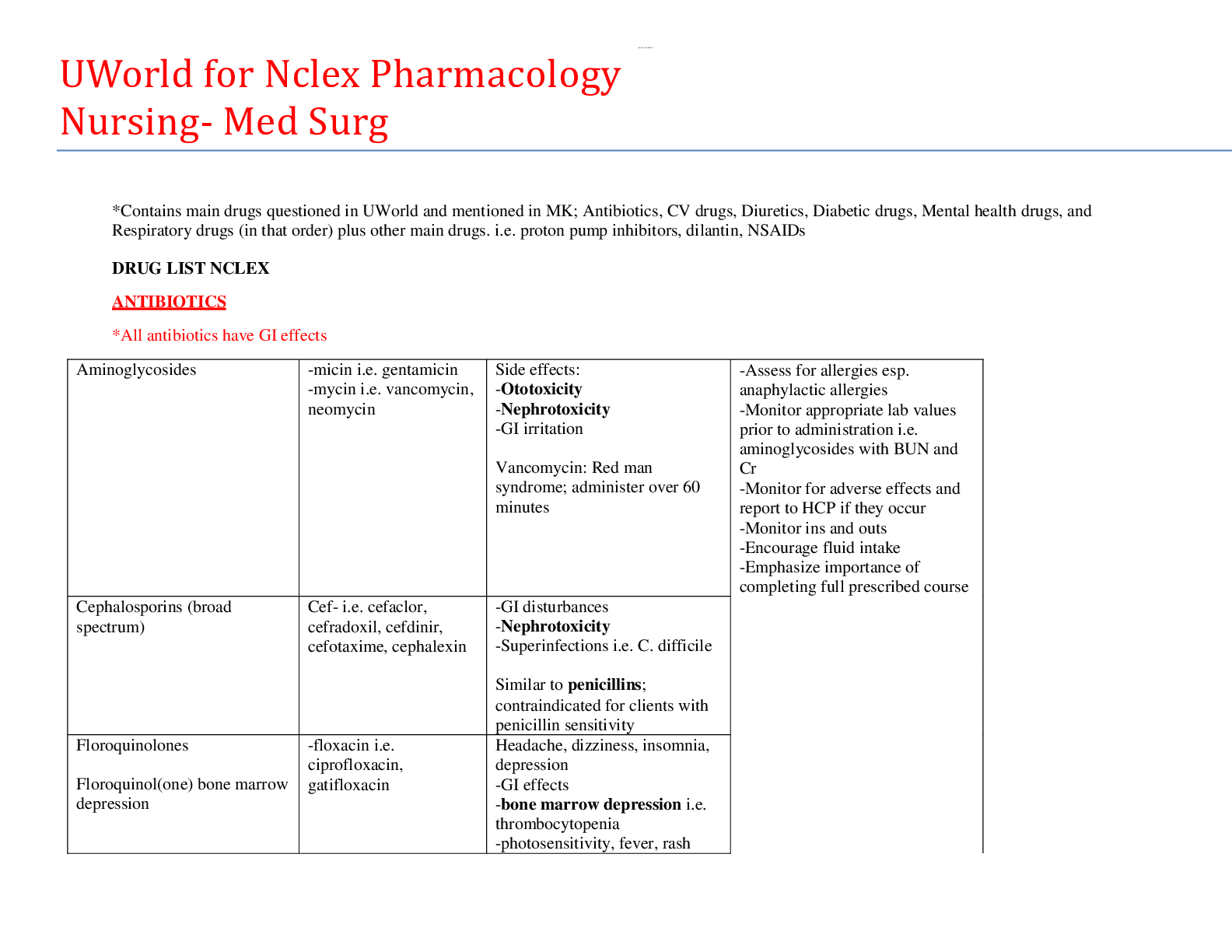

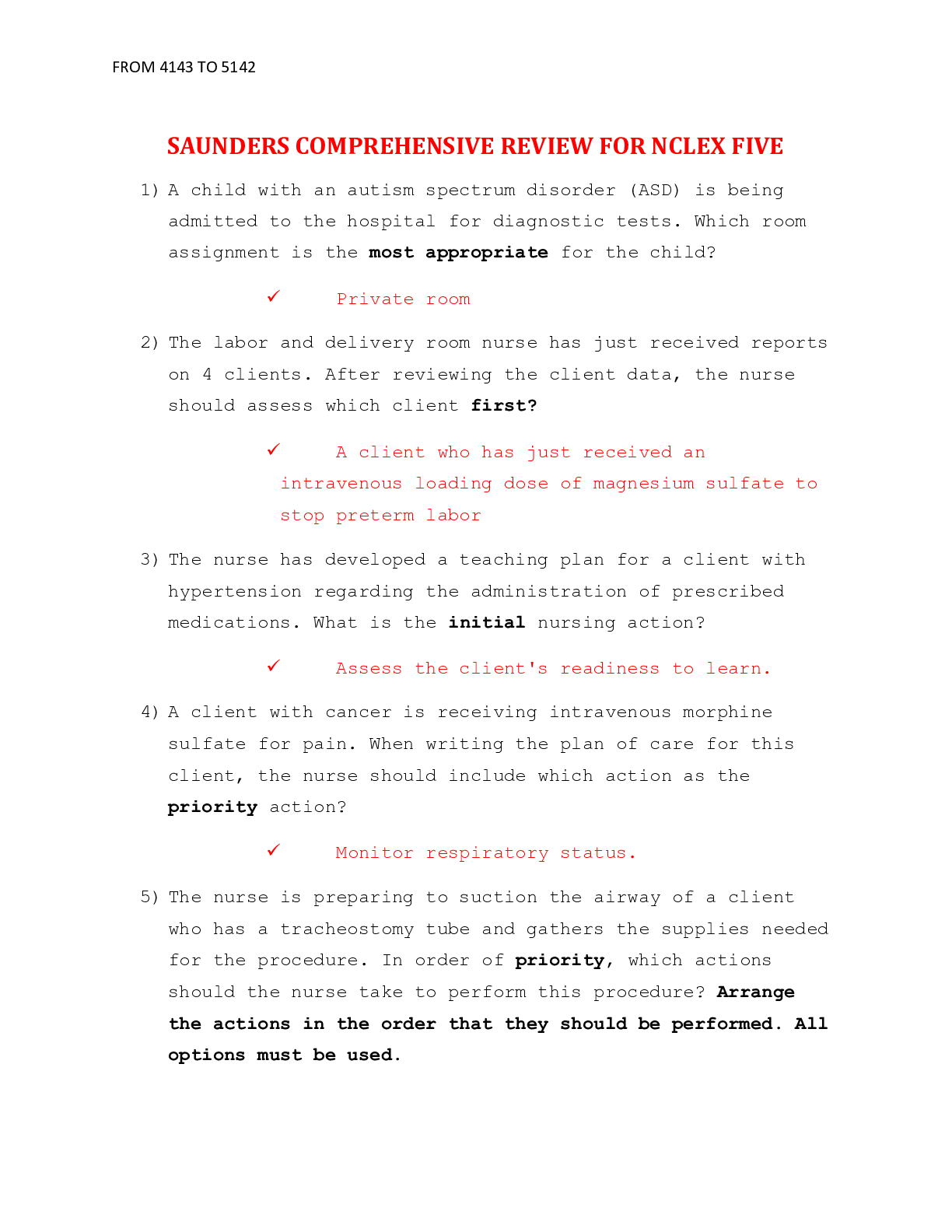
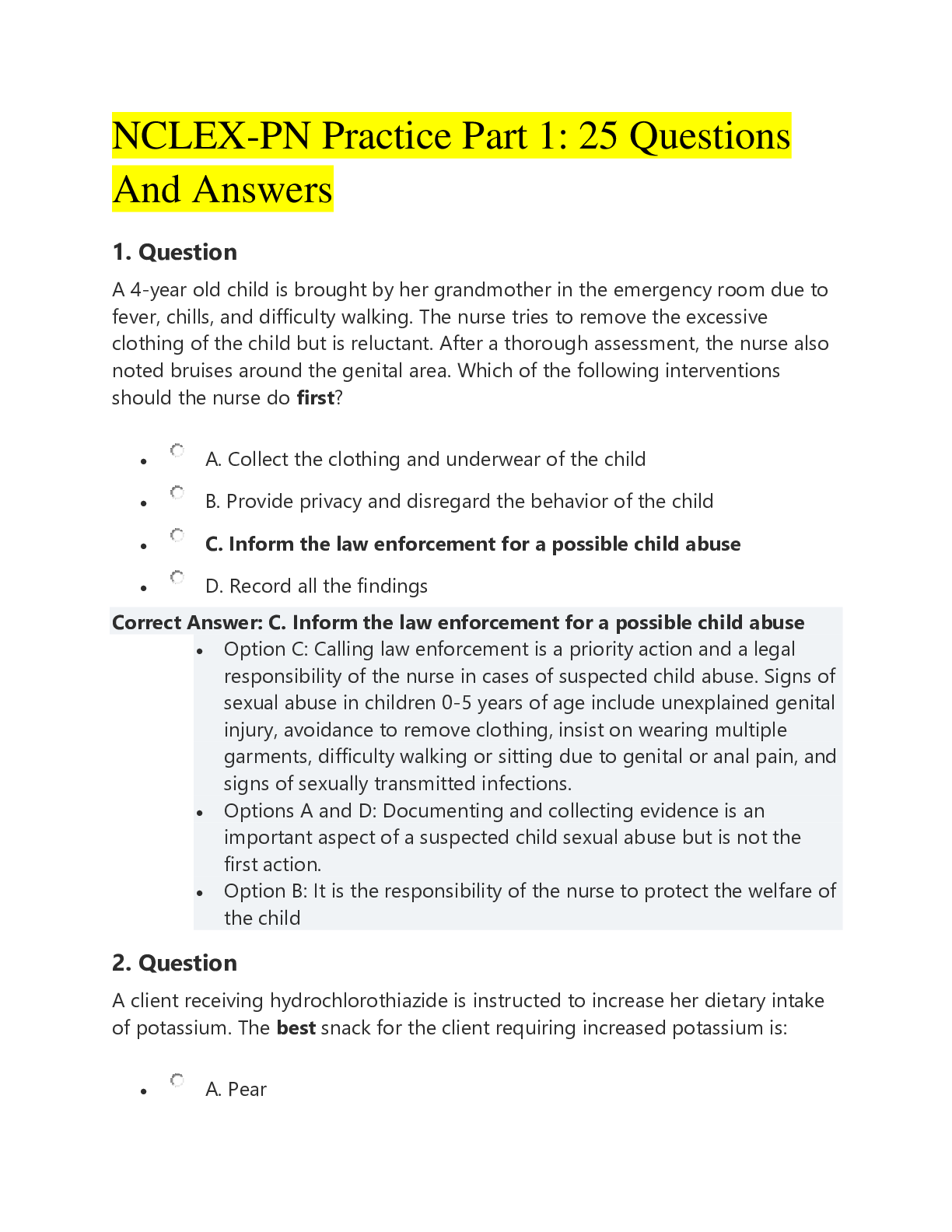
.png)
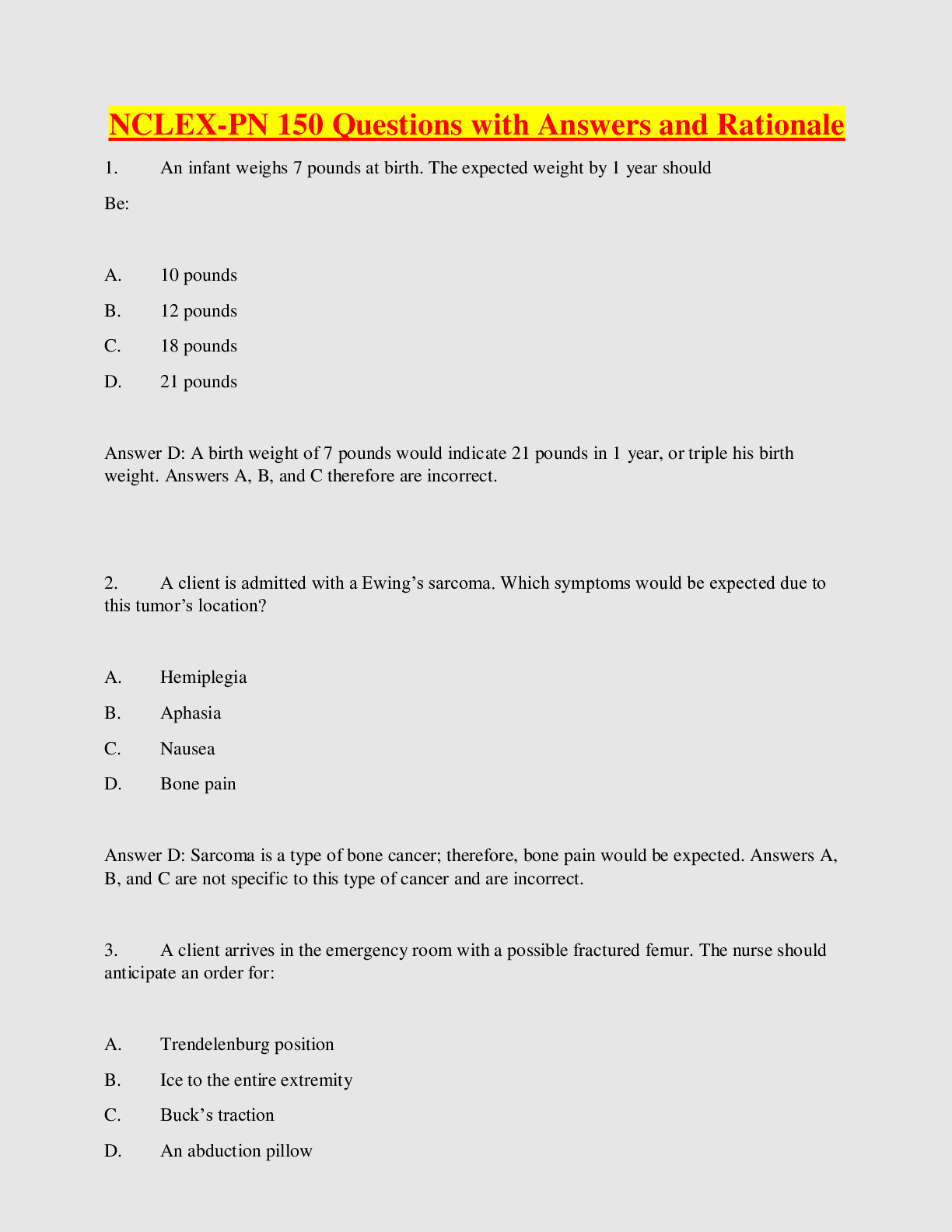


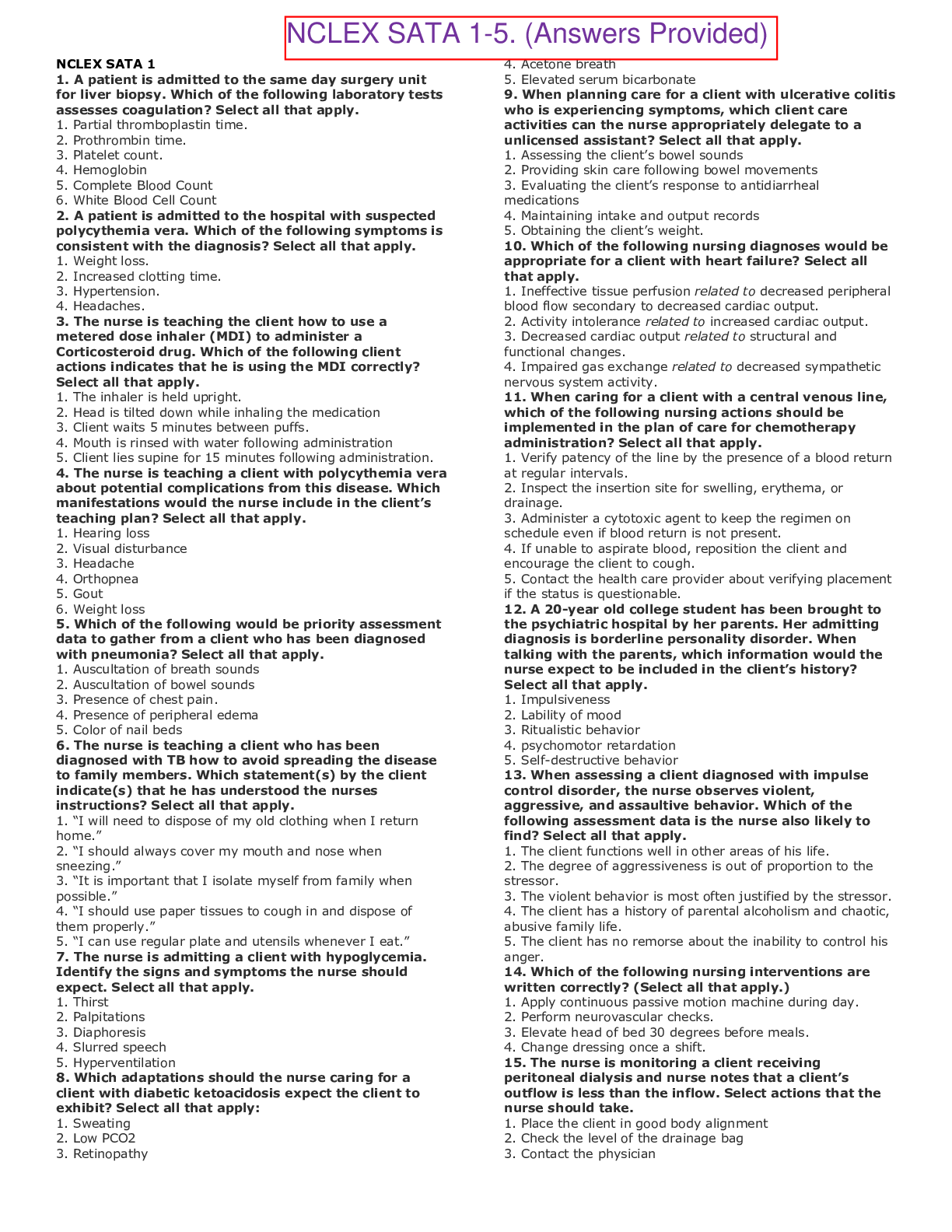
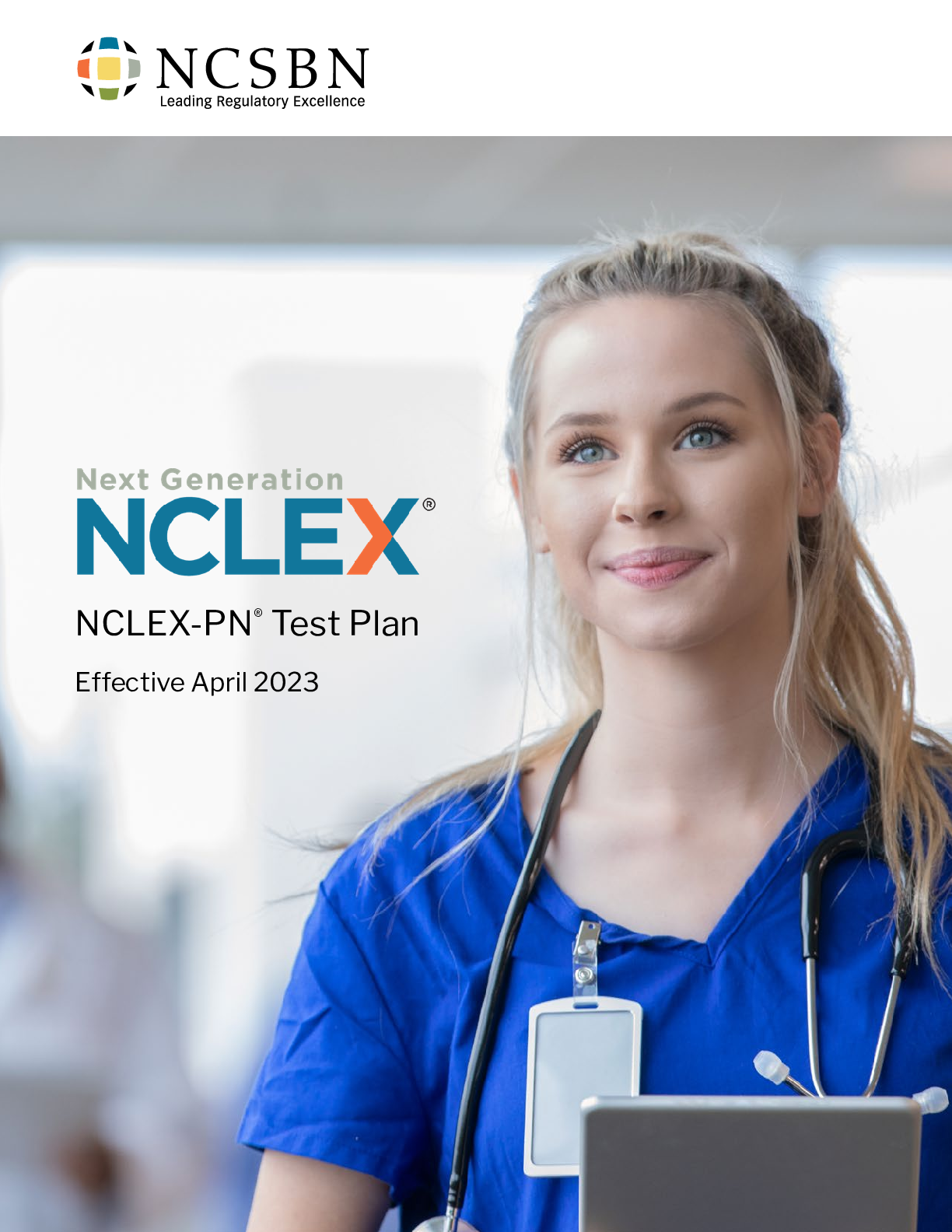

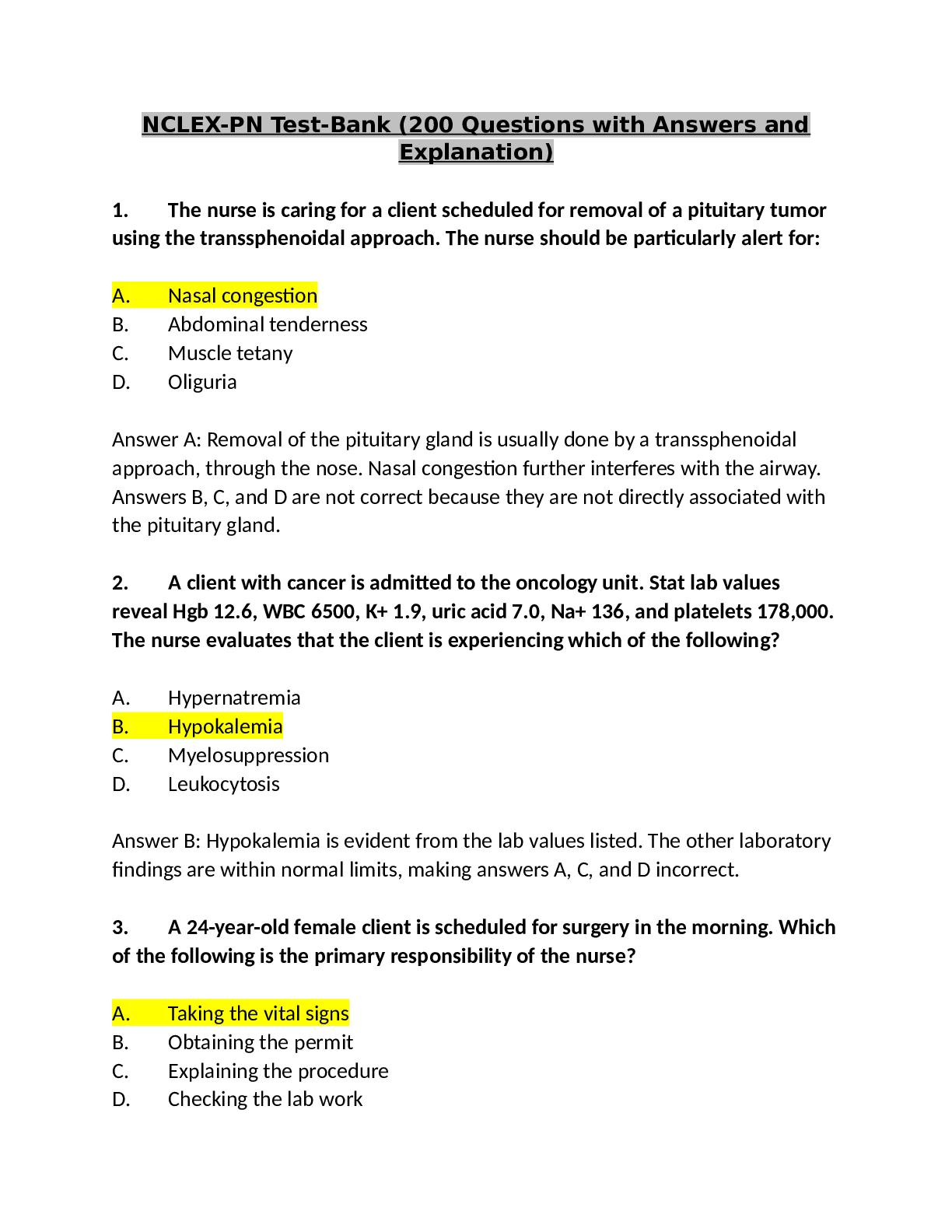

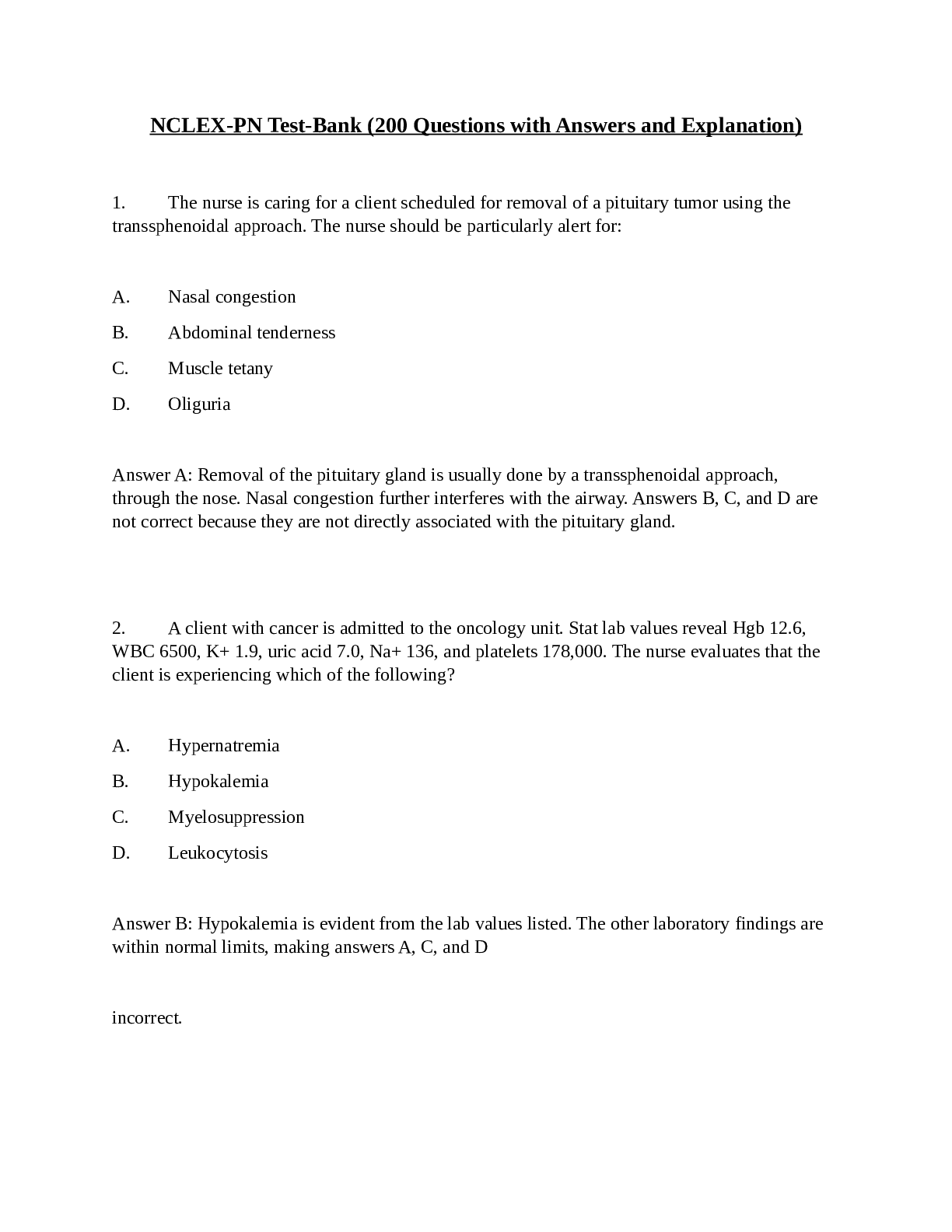
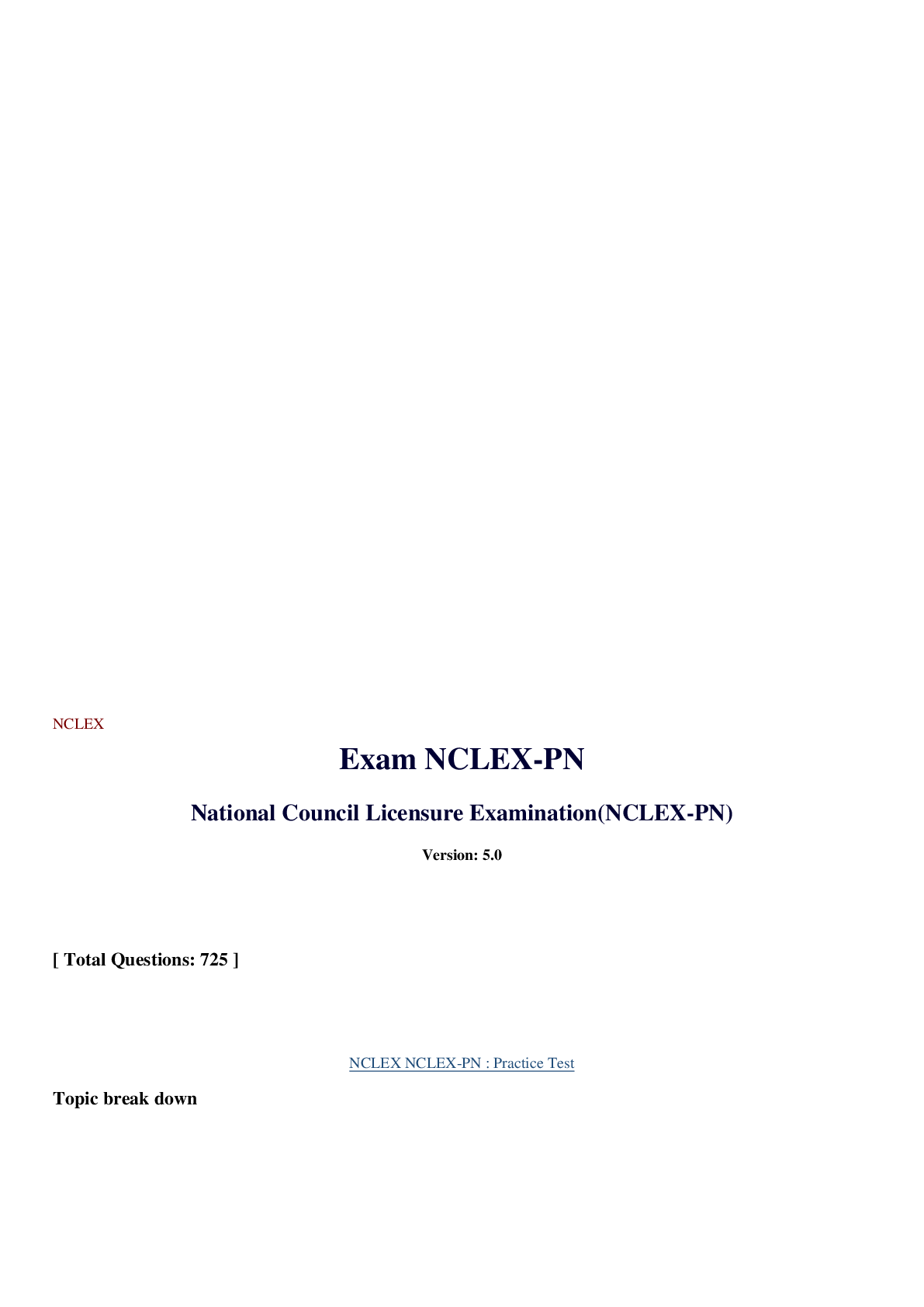
.png)
 Latest 2022-2023.png)

